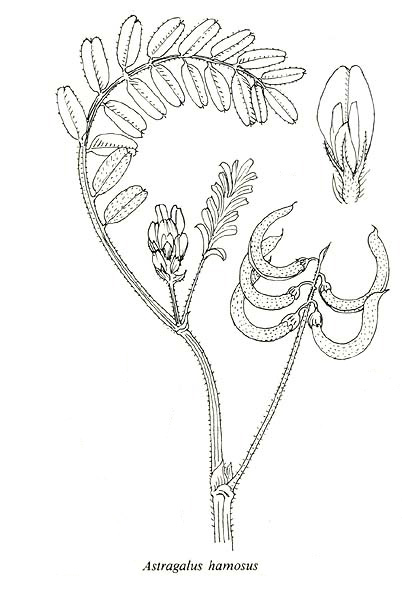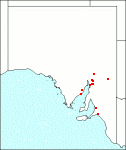Family: Fabaceae
Astragalus hamosus
Citation:
L., Sp. Pl. 758 (1753).
Synonymy: Not Applicable Common name: Yellow) milk-vetch, hook-pod.
Description:
Prostrate or ascending annual or biennial; stems 10-50 cm high, pubescent with flat appressed medifixed hairs; leaves imparipinnate, narrowly oblong, 3-15 cm long; leaflets 5-21, oblong, 5-18 x 2-7 mm, retuse, glabrous above, thinly appressed-strigose below; stipules ovate, acuminate, 3-7 x 2.5-5 mm, adnate to the petiole, ciliate.
Inflorescence axillary, rather congested, a pedunculate raceme, to 12 cm long, 4-8- rarely to 15-flowered; peduncle densely strigose, at first very short to 5 cm, lengthening in fruit; flowers erect, sessile, c. 8 mm long, yellowish-white; bracts linear-lanceolate, 2-4 x c. 0.5 mm, membranous, midrib ending in a subulate point; calyx narrowly campanulate, 4-6 mm long, appressed-fusco-strigose; calyx teeth subequal, subulate, shorter than the calyx tube; bracteoles wanting; standard obovate-oblong, c. 7 x c. 3 mm, emarginate, gradually tapering to a wide claw; wings and keel shorter, their base conspicuously auriculate; ovary narrow-oblong, hairs appressed, gradually tapering into a glabrous style.
Pod sessile, cylindrical, 20-50 x 2-3 mm, acuminate at the apex, curved through about a semicircle, laterally compressed, many-seeded, valves not keeled, almost smooth, sometimes with short appressed hairs; seeds triangular or reniform, compressed, c. 2 mm long; testa light-brown, somewhat rugulose-pitted.

|
|
Image source: fig. 324A in J.P. Jessop and H.R. Toelken Ed. 1986. Flora of South Australia (4th edn).
|
Published illustration:
Zohary (1972) Flora Palaestina 2: pl. 87.
|
|
Distribution:
|
S.Aust.: FR, EA, EP, SL. Qld; N.S.W.; Vic.;. Native to the Mediterranean region and eastwards to Iran and the Atlantic Islands.
|
Conservation status:
native
Flowering time: Sept. — Nov.
|

SA Distribution Map based
on current data relating to
specimens held in the
State Herbarium of South Australia
|
Biology:
No text
Author:
Not yet available
|

